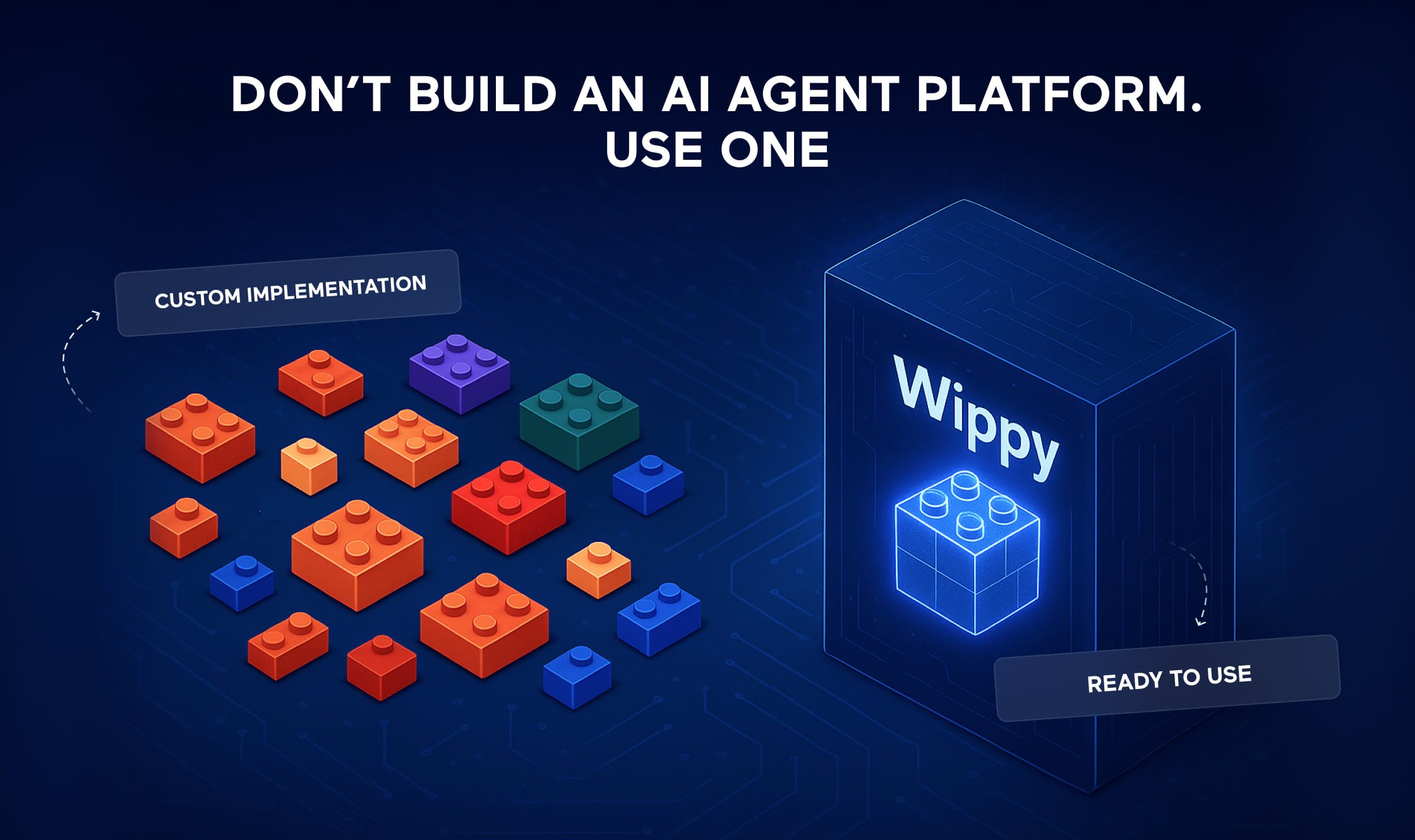Structured AI agents offer a superior approach to business automation compared to chatbots. By utilizing structured AI agents and enabling agent-powered quoting automation, businesses can achieve scalable, intelligent solutions.
Most people’s first interaction with AI came through chatbots like ChatGPT—a reactive assistant that responds to queries in plain English. While useful for casual inquiries, chatbots often fall short in handling complex business workflows, leaving users frustrated. This misunderstanding leads to one of the most common questions we hear from product leaders evaluating Wippy: “Is Wippy just a better chatbot or chat assistant?” No, Wippy is not a chatbot. It’s a full platform for structured, repeatable, versioned AI automation—where agents don’t just talk back, they work in coordination with swarms of other agents with purpose and on tasks.
Chatbots Are Like Asking a Genius Once
Chatbots, whether built on GPT-4, Claude, or Gemini, are fundamentally prompt-and-response systems. They’re trained on a massive amount of data and respond based on probability, i.e., what sounds like a good answer. You might ask:
- “Summarize this email thread and help me write a response.”
- “What’s the average cost per unit for Q1?”
- “Write me a follow-up note for this lead based on what I have shared.”
And the responses might do a good job for you. Or not. Because every time you ask, you’re starting from scratch. Same question, different day? You very well could get different results. And if the output is wrong or missing context, good luck auditing why.
Agents Are Designed to Think Like Your Business
AI agents are like your trained digital employees. They take the power of LLMs and give them guardrails based on your tribal knowledge and data. Instead of prompting ad hoc, you define a custom AI agent development once—its goals, inputs, tools it can use, what knowledge it has access to, and how it should behave in various scenarios.
In Wippy, this happens through a declarative configuration system:
- Prompt templates with reusable fragments (“traits”)
- Tool access tied to real backend services (functions or APIs)
- Embedded memory, so agents remember state or context
- Execution rules and fallbacks to handle complexity or edge cases
- Versioned logic so you can trace and rollback changes
Think of it like designing a role and how you would onboard a new employee, not just writing a one-off message for a random task. You’re building something persistent. One that can act again and again with consistent results, governed by data and structure, not luck or something that will hallucinate a result for you.
Ask Once, Get Lucky vs. Design Once, Tweak a bit, and Reuse Everywhere
This is the biggest mindset shift when moving from chatbot-style tools to an agent-based platform like Wippy. Users need to reorient their brains to thinking about breaking down concepts and workflows into smaller, manageable components that can be reused and refined over time.
Chatbots | Wippy AI Agents |
Prompt one-off questions | Design reusable workflows |
Results vary with each run | Deterministic logic + fallbacks |
No memory of prior tasks | Built-in context and state |
Limited integration with systems | Deep integration with APIs & tools |
Great for demos | Built for real work |
Example: AI for Customer Onboarding
In customer onboarding, structured AI agents can automate the entire process, from initial contact to account setup, ensuring a seamless and personalized experience for each client.
Let’s say your support team onboards new customers for your SaaS product. In a chatbot world, they might paste customer info into a tool and ask:
“Can you write me an onboarding email for this customer?”
Sometimes it sounds great. Sometimes it misses key integrations or compliance notes. With Wippy, you’d build a specific Onboarding Agent with:
- A prompt template that includes product details, user role, and tone
- Access to a tool that fetches account data via API
- Traits for tone, brevity, and call-to-action structure
- Memory of recent onboarding messages so it doesn’t repeat content
Now? Your team can trigger that agent with a button or an API, while still keeping them informed and in the loop. And they get the same quality, same format, every time.
Example: AI for Financial Summarization
For financial summarization, agents can analyze complex datasets, generate accurate reports, and provide insights, all while adhering to predefined business rules and standards.
Imagine you’re in finance, reviewing monthly consolidated reports. You want an AI to read through P&Ls, spot anomalies, missed forecasts, cost overruns and summarize insights. A chatbot might help once. But it won’t remember that last month’s format changed, how you want the information presented, or that your CFO likes a bullet list with EBITDA variance.
A Wippy trained agent, by contrast, can be built to:
- Expect and parse your specific spreadsheet format or pull from your 3rd party finance software
- Pull data into structured summaries and build a knowledge based on your unstructured information
- Apply reasoning rules (e.g., flag variances >10%)
- Produce output in your reporting template
- Log every run, so you can audit and refine
And because there is the history of different versions of your agent in Wippy’s memory, you can roll back changes or rules you have created, in an instant, if anything breaks or the outcome isn’t what you expected.
Structure Doesn’t Mean Rigid
Structured AI agents offer flexibility and adaptability. They can adjust to new data, learn from interactions, and continuously improve, making them ideal for dynamic business environments.
A common objection is: “But won’t this make our AI less flexible?”
Actually, it makes it more usable.
Because you can always build agents that call other specialized agents. Or allow an agent to take open-ended input and refine it through a structured process. You can still have the flexibility of a conversation—but now it’s powered by reusable, customizable building blocks, not one-time prompts.
The result? Less prompt tweaking. More output you can trust.
Real Business Impact
The real impact of structured AI agents lies in their ability to deliver consistent, reliable results. By leveraging agent-powered quoting automation, businesses can streamline operations, reduce errors, and enhance customer satisfaction.
The shift from chatbots to AI agents isn’t just technical. It changes how your teams work:
- Customer Success builds onboarding playbooks once, uses them at scale, and the information doesn’t now just reside in a single person’s head.
- Marketing reuses persona-driven copy agents across campaigns.
- Product Managers deploy support agents that reference live docs and FAQs.
- Ops automate reporting without waiting for engineering.
No more “What prompt do I need this time?” Just: “Which task do I need help with?” and let the agents coordinate to determine who is the best one to execute your task.
Wippy Makes Agent Design Accessible
Wippy simplifies the design and deployment of structured AI agents, making it accessible to businesses of all sizes. Its intuitive platform allows users to create, manage, and optimize agents with ease, unlocking new opportunities for growth and innovation.
You might be thinking: “This sounds great—but isn’t agent architecture hard or is this not a reality in today’s AI space?”
Not with Wippy.
Wippy was built to make agent creation feel like product design, using words to describe them and not code or block diagrams that can confuse and frustrate the user experience.
You can:
- Use natural language prompts to define goals
- Choose from agent templates with working examples
- Link tools that Wippy has created to get the tasks done on your behalf (or we help you build AI Agents at scale)
- Deploy agents inside your app, support portal, or internal tools
You can even have Wippy’s own agents help you create new agents. Yes, really.
Final Thought: Chatbots Are the Starting Line, Not the Finish Line
Chatbots serve as an introduction to AI, but structured AI agents represent the future of business automation. By embracing this technology, businesses can achieve greater efficiency, scalability, and success.
If you’re serious about AI helping your team move faster, deliver repeated/reliable outcomes, and reduce repetitive work that bogs down your team—you don’t want a chatbot.
You want a structured, smart, reusable agent. One that knows what to do. When to create tools. When to call other agents to help. And how to do it again.
That’s what Wippy delivers.
Need help integrating structured AI agents into your business processes?



